
Wakefield is a village in the town of South Kingstown, Rhode Island, United States, and the commercial center of South Kingstown. Together with the village of Peace Dale, it is treated by the U.S. Census as a component of the census-designated place identified as Wakefield-Peacedale, Rhode Island. West Kingston, another South Kingstown village, was the traditional county seat of Washington County. Since 1991, the Washington County Courthouse has been in Wakefield. The Sheriff's Office which handles corrections is also in Wakefield.

Saunderstown is a small village and historic district in the towns of Narragansett and North Kingstown in Washington County, Rhode Island, United States. Saunderstown has its own post office with the ZIP Code of 02874, which also includes a small part of South Kingstown. Its population is 6,245.

Casey Farm is a historic farm in Saunderstown, Rhode Island, United States. It is now a historic museum property, operated by Historic New England, and is open to the public.

Smith's Castle, built in 1678, is a house museum at 55 Richard Smith Drive, near Wickford, a village in North Kingstown, Rhode Island, United States. Smith's Castle is one of the oldest houses in the state. It was designated a National Historic Landmark in 1993 as Cocumscussoc Archeological Site, due to the artifacts and information digs in the vicinity have yielded. It is located just off U.S. 1.

Carolina is a village that straddles the border of the towns of Charlestown and Richmond on the Pawcatuck River in Washington County, Rhode Island. Rhode Island Route 112 passes through the village. Carolina is identified as a census-designated place, with a population of 970 at the 2010 census.
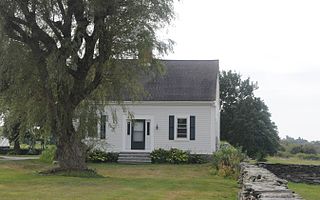
The Bailey Farm is an historic farm at 373 Wyatt Road in Middletown, Rhode Island. Now reduced from more than 100 acres (40 ha) to about 45 acres (18 ha), the farm is a well-preserved example of a 19th-century island farm. It was owned by members of the Bailey family, possibly as early as the late 17th century, into the 19th century. The original main house appears to be a mid-18th century structure that was given a significant Greek Revival treatment in the 19th century. It is a 1-1/2 story Cape style house, three bays wide, with a central chimney. The main entrance is centered on the northern facade, and is flanked by sidelight windows and pilasters, with an entablature above. The corners of the building are pilastered. A series of outbuildings stand nearby. There is a second complex of buildings on the northwest part of the property, built in the 1930s near the location of the Bailey family cemetery.

The Cook–Bateman Farm is a colonial-era farmstead located at the intersection of Fogland, Puncatest Neck and Pond Bridge Roads in Tiverton, Rhode Island. The property was initially purchased in 1700 and reached its largest size, 200 acres (81 ha), in the last 25 years of the 18th century. It currently encompasses 63 acres (25 ha) of rolling farmland.

The Andrews–Luther Farm is a historic farm in Scituate, Rhode Island. It is located on the south side of Elmdale Road, a short way east of its junction with Harmony Road. The farm is a 45-acre (18 ha) property, with its main house, a c. 1768 wood-frame structure set near the road. It is 2+1⁄2 stories high, with a large central chimney, and a center entry on the south facade with vernacular Greek Revival styling. A corn crib dating to the late 19th or early 20th century stands further south on the property, and the foundational remains of older buildings dot the area. The farm is distinctive for retaining a large portion of its original setting, and for the detailed accounts of it which have been retained by Harley Luther's descendants.
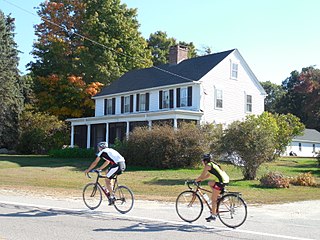
The Mathewson Farm is an historic farm on 544 Greenville Avenue in Johnston, Rhode Island. It is an agricultural remnant of the formerly rural village of Belknap. The centerpiece of the farm complex is a late 18th-century farmhouse with vernacular Federal styling. Surviving outbuildings of the farm include a barn from the early 20th century, a henhouse, and a silo. This property was developed as a farm by William Mathewson in the 1790s, and was actively farmed by his descendants until the 1940s.

Mt. Hygeia is an historic farm property at 83 Mt. Hygeia Road in Foster, Rhode Island.
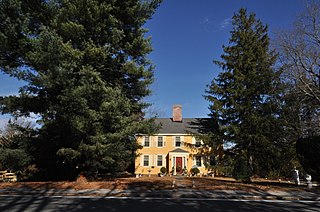
The Whipple–Cullen House and Barn is an historic farmstead on Old River Road in Lincoln, Rhode Island. The main house is a 2+1⁄2-story wood-frame structure, five bays wide, with a large central chimney and a gable roof. An addition extends to the rear, and a 19th-century porch is on the side of the house. The barn, dating to the late 19th century, is north of the house, and there is a former farm shed, now converted to a garage, to its south. The property is located across the street from the Lincoln town offices. The house, built c. 1740, is one of the town's least-altered 18th century houses, and the barn is a rare survivor of the town's agrarian past.
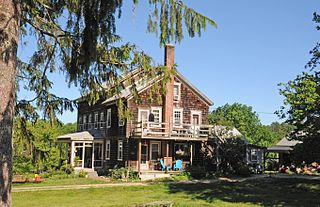
The Austin Farm Road Agricultural Area is a rural historic district in Exeter, Rhode Island. The district is bounded on the east by Interstate 95, on the north by the town line, on the south by Austin Farm Road, and on the west by a north-south line through Austin Farm Pond. This agricultural area is relatively little altered since the late 19th century, despite the proximity of the interstate. It includes the farm complex built up by John Austin in the 19th century, which continues to see active use, and the site of an older farm complex, reduced to just the farmhouse, which predates Austin's acquisition of the property. In addition to the farm buildings, it includes a chapel and school house built or maintained by Austin.

Black Farm, also known as the Isaac Collins Farm, is a historic farm in Hopkinton, Rhode Island bounded by Woodville Alton Road and Wood Road. The 264-acre (107 ha) was first developed by John Collins beginning in 1710, and saw agricultural use for over 200 years. The main house dates to the late 18th century, and is a 1-1/2 story gambrel-roofed post-and-beam structure. Other outbuildings include 19th century barns, a corn crib, and a guest cottage added in the 1930s. Set some distance off from this complex of buildings is the foundational remnant of what was probably an ice house: it consists of granite blocks and is eight feet in height.

The John Hoxsie House, also known as the Old Kenyon Farm, is an historic farmstead in Richmond, Rhode Island. The farm is a 60-acre (24 ha) parcel of land accessed via a long private drive on the east side of Richmond Town House Road, just north of Pinecrest Road, and is a rare, virtually intact, example of a 19th-century farmstead. The main house, a 1-1/2 story Cape style structure, was built in 1784 by John Hoxsie.

The Kingston Hill Farm, also known as the Potter-Peckham Farm, is a historic farm in South Kingstown, Rhode Island. The 20-acre (8.1 ha) farm is centered on a building complex with a c. 1810 1-1/2 story wood frame farmhouse, which follows a typical plan of five bays with a central chimney. Behind the house are a seed barn and wagon shed, both dating to the early 20th century. A family cemetery with 18th-century graves is located near the southern boundary of the property. The farm was first established by William Potter in the 1730s; by the early 18th century it came into the hands of Elisha Reynolds Potter, who operated it as a tenant farm. Potter tore down the original farmhouse and built the now-surviving smaller house.
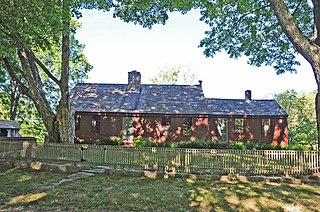
The Simon Lillibridge Farm is an historic farm property at 75 Summit Road in Exeter, Rhode Island. The 38-acre (15 ha) property is all that remains of an original 200-acre (81 ha) parcel purchased by Simon Lillibridge in the 1810s. The main house, a two-story wood-frame structure, was either built by Lillibridge, or was already on the property when he bought it. Architectural analysis of the house suggests that at least portions of it were built in the 18th century, with hand-hewn beams, and other stylistic elements suggesting construction during the Georgian period. The farm complex includes other 19th-century buildings, including a barn, shed, wagon shed, and outhouse, as well as a family cemetery. The property was in regular agricultural use until about 1935, and was used thereafter as a summer residence.

The Henry Marchant Farm is an historic farm on South County Trail in rural western South Kingstown, Rhode Island. The main house of the farm is a 2+1⁄2-story wood-frame structure, probably built by Joseph Babcock. Construction is traditionally dated to the 1750s, but architectural evidence suggests it may have been built earlier—possibly between 1720 and 1740. The house has well-preserved vernacular Federal styling, including a main entry framed by Doric pilasters and an entablature. The farmstead includes an early 20th-century barn, a carriage house, and an old privy, as well as the family cemetery of the Marchant family. The property was purchased in 1774-75 by Henry Marchant, a leading Newport merchant and politician.

The Wilbor House is a historic house museum at 548 West Main Road in Little Compton, Rhode Island, and currently serves as the headquarters of the Little Compton Historical Society. The property includes eight buildings of historical significance, six of which were part of the Wilbor farmstead, a complex that was used for farming between 1690, when the east end of the house was built, and 1955, when the property was acquired by the historical society. The house is a 2½-story wood-frame structure, whose oldest portion was probably a stone ender built by Samuel Wilbor, and whose western half was added c.1740, giving it a Georgian appearance. Two ells were added c.1860, and additiona expansions were made in 1967. The five farm outbuildings include an 18th-century outhouse, a c.1800 barn, and corn crib and carriage house, both of which were built c.1850. Two additional non-contributing structures are on the property, the frame of a c.1750 barn covered in modern materials, and a modern replica of an 18th-century schoolhouse.

Norman Bird Sanctuary is a 325-acre (1.32 km2) bird sanctuary, nature preserve, environmental education center, and museum at 583 Third Beach Road in Middletown, Rhode Island overlooking the Atlantic Ocean.

The Spencer–Shippee–Lillbridge House, also known as the Crossways Farm and Walnut Brook Farm, is a historic farmstead at 12 Middle Road in East Greenwich, Rhode Island. The main house is a 2+1⁄2-story timber-frame structure, five bays wide and three bays deep, whose construction date is traditionally given as 1772. There is, however, architectural evidence that it may be older. The building has a small 19th century addition, whose purpose was to provide a staircase for hired farmhands to reach the attic, where their living space was. The downstairs spaces have retained much of their original Georgian fabric, although a pantry space has been converted into a modern kitchen. There are five outbuildings on the 1.3-acre (0.53 ha) property, including a 19th-century wagon shed and horse barn. The house, once the centerpiece of a 225-acre (91 ha) farm, was held by members of the interrelated Spencer, Shippee, and Lillbridge families from its inception until 2001.






















